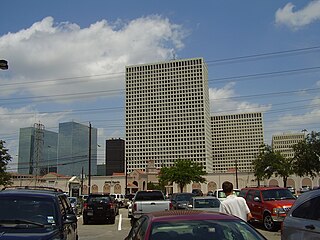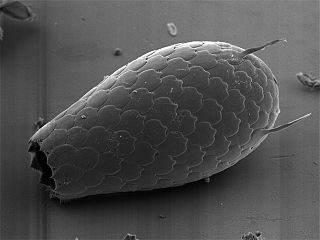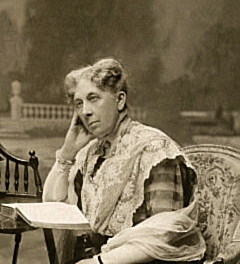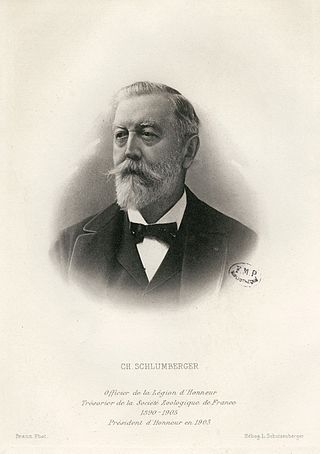
The Norwegian Institute of Technology was a science institute in Trondheim, Norway. It was established in 1910, and existed as an independent technical university for 58 years, after which it was merged into the University of Trondheim as an independent college.

Schlumberger NV, doing business as SLB, also known as Schlumberger Limited, is an American oilfield services company. As of 2022, it is both the world's largest offshore drilling company and the world's largest offshore drilling contractor by revenue.

WesternGeco is a geophysical services company. It is headquartered in Schlumberger House on the property of London Gatwick Airport in Crawley, West Sussex.
Retrogradation is the landward change in position of the front of a river delta with time. This occurs when the mass balance of sediment into the delta is such that the volume of incoming sediment is less than the volume of the delta that is lost through subsidence, sea-level rise, and/or erosion. As a result, retrogradation is most common:

Transocean Ltd. is an American drilling company. It is the world's largest offshore drilling contractor based on revenue and is based in Vernier, Switzerland. The company has offices in 20 countries, including Canada, the United States, Norway, United Kingdom, India, Brazil, Singapore, Indonesia, and Malaysia.

Giuseppe Antonio Risso, called Antoine Risso, was a Niçard and naturalist.

The euglyphids are a prominent group of filose amoebae that produce shells or tests that in most described species is reinforced by siliceous scales, plates, and sometimes spines, but this reinforcement is absent in other species. These elements are created within the cell and then assembled on its surface in a more or less regular arrangement, giving the test a textured appearance. There is a single opening for the long slender pseudopods, which capture food and pull the cell across the substrate.

Guebwiller is a commune in the Haut-Rhin département in Grand Est currently in north-eastern France. It was a sub-prefecture of the department until 2015.
Société nationale des pétroles du Congo is a national oil company of the Republic of the Congo. The company was established in 1998 after the dissolution of the public company Hydro-Congo. The company manages government-owned shares of production from oil fields in the country. The company has stakes in Moho-Bilondo (15%), Nkossa (15%), M'Boundi (8.8%), Kitina (35%), Sendji (15%), Yanga (15%), Djambala (35%), Foukanda (35%), Mwafi (35%), Emeraude (49%), Yombo (44%), Tilapia (35%), Azurite (15%), and Turquoise Marine-1 (15%) fields. It owns the refinery company named Congolaise de Raffinage (CORAF).

Crassispira is a genus of small predatory sea snails with narrow, high-spired shells, marine gastropod mollusks in the family Pseudomelatomidae. They first appeared in the fossil record approximately 48.6 million years ago during the Eocene epoch, and still exist in the present day.
Events from the year 1853 in France.

Ferdinand Chalandon was a French medievalist and Byzantinist.

Léon Gustave Schlumberger was a French historian and numismatist who specialised in the era of the crusades and the Byzantine Empire. His Numismatique de l'Orient Latin (1878–82) is still considered the principal work on the coinage of the crusades. He was awarded the medal of the Royal Numismatic Society in 1903. A large portion of his extensive Crusader coin collection is housed in the Cabinet des Médailles a department of the Bibliothèque nationale de France in Paris.

Gyrineum is a genus of predatory sea snails, marine gastropod mollusks in the family Cymatiidae.

The Battle of Apamea was fought on 19 July 998 between the forces of the Byzantine Empire and the Fatimid Caliphate. The battle was part of a series of military confrontations between the two powers over control of northern Syria and the Hamdanid emirate of Aleppo, which in turn were part of the larger series of regional conflicts known as the Arab–Byzantine wars. The Byzantine regional commander, Damian Dalassenos, had been besieging Apamea, until the arrival of the Fatimid relief army from Damascus, under Jaysh ibn Samsama. In the subsequent battle, the Byzantines were initially victorious, but a lone Kurdish rider managed to kill Dalassenos, throwing the Byzantine army into panic. The fleeing Byzantines were then pursued, with much loss of life, by the Fatimid troops. This defeat forced the Byzantine emperor Basil II to personally campaign in the region the next year, and was followed in 1001 by the conclusion of a ten-year truce between the two states.

Cameron International Corporation (formerly Cooper Cameron Corporation (CCC) and Cooper Oil Tool, Cameron Iron Works) though now operating under Schlumberger, is a global provider of pressure control, production, processing, and flow control systems as well as project management and aftermarket services for the oil and gas and process industries. Cameron was acquired by Schlumberger (SLB) in 2016, and now operates as 'Cameron, an SLB Company.' At the start of the SLB acquisition in 2015, Cameron employed approximately 23,000 people and delivered $9.8 billion in revenue.

Marguerite de Witt-Schlumberger was a French campaigner for pronatalism, alcoholic abstinence, and feminism. She was the president of the French Union for Women's Suffrage movement. She married into the Schlumberger family and became a powerfully influential matriarch and the mother of several sons who achieved notability in their own right. An activist in international women's rights circles, Witt-Schlumberger was a leading suffragist at the Paris Peace Conference in 1919. For her active involvement and service to the government, she was awarded the Croix of the French Legion of Honour in 1920.

Parthian art was Iranian art made during the Parthian Empire from 247 BC to 224 AD, based in the Near East. It has a mixture of Persian and Hellenistic influences. For some time after the period of the Parthian Empire, art in its styles continued for some time. A typical feature of Parthian art is the frontality of the people shown. Even in narrative representations, the actors do not look at the object of their action, but at the viewer. These are features that anticipate the art of medieval Europe and Byzantium.

Charles Schlumberger was a French paleontologist, known for his studies of Foraminifera, both living and fossil species.
Jean Riboud was a French socialist, corporate executive and the chairman of Schlumberger, the largest oilfield services company in the world. He was a member of the French Resistance during World War II and suffered incarceration in Buchenwald concentration camp of the Nazis. His contributions were reported in making Schlumberger into the market leader in oilfield services sector. The Government of India awarded him the third highest civilian honour of the Padma Bhushan, in 1986, for his contributions to society.
















